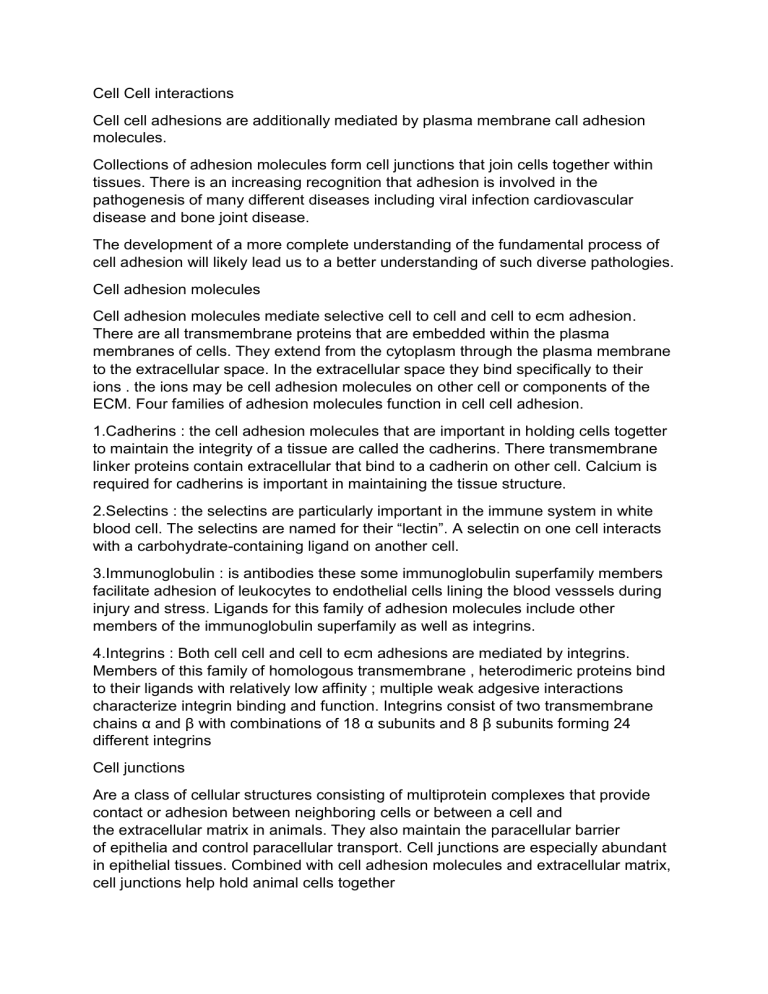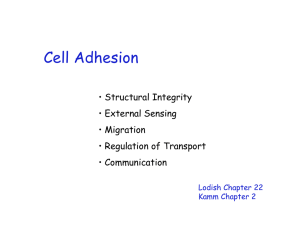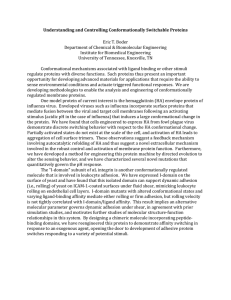Cell Adhesion & Junctions: Molecules, Types, and Functions
advertisement

Cell Cell interactions Cell cell adhesions are additionally mediated by plasma membrane call adhesion molecules. Collections of adhesion molecules form cell junctions that join cells together within tissues. There is an increasing recognition that adhesion is involved in the pathogenesis of many different diseases including viral infection cardiovascular disease and bone joint disease. The development of a more complete understanding of the fundamental process of cell adhesion will likely lead us to a better understanding of such diverse pathologies. Cell adhesion molecules Cell adhesion molecules mediate selective cell to cell and cell to ecm adhesion. There are all transmembrane proteins that are embedded within the plasma membranes of cells. They extend from the cytoplasm through the plasma membrane to the extracellular space. In the extracellular space they bind specifically to their ions . the ions may be cell adhesion molecules on other cell or components of the ECM. Four families of adhesion molecules function in cell cell adhesion. 1.Cadherins : the cell adhesion molecules that are important in holding cells togetter to maintain the integrity of a tissue are called the cadherins. There transmembrane linker proteins contain extracellular that bind to a cadherin on other cell. Calcium is required for cadherins is important in maintaining the tissue structure. 2.Selectins : the selectins are particularly important in the immune system in white blood cell. The selectins are named for their “lectin”. A selectin on one cell interacts with a carbohydrate-containing ligand on another cell. 3.Immunoglobulin : is antibodies these some immunoglobulin superfamily members facilitate adhesion of leukocytes to endothelial cells lining the blood vesssels during injury and stress. Ligands for this family of adhesion molecules include other members of the immunoglobulin superfamily as well as integrins. 4.Integrins : Both cell cell and cell to ecm adhesions are mediated by integrins. Members of this family of homologous transmembrane , heterodimeric proteins bind to their ligands with relatively low affinity ; multiple weak adgesive interactions characterize integrin binding and function. Integrins consist of two transmembrane chains α and β with combinations of 18 α subunits and 8 β subunits forming 24 different integrins Cell junctions Are a class of cellular structures consisting of multiprotein complexes that provide contact or adhesion between neighboring cells or between a cell and the extracellular matrix in animals. They also maintain the paracellular barrier of epithelia and control paracellular transport. Cell junctions are especially abundant in epithelial tissues. Combined with cell adhesion molecules and extracellular matrix, cell junctions help hold animal cells together Tight junctions Found in vertebrate epithelia, tight junctions act as barriers that regulate the movement of water and solutes between epithelial layers. Tight junctions are classified as a paracellular barrier which is defined as not having directional discrimination; however, movement of the solute is largely dependent upon size and charge. There is evidence to suggest that the structures in which solutes pass through are somewhat like pores. Physiological pH plays a part in the selectivity of solutes passing through tight junctions with most tight junctions being slightly selective for cations. Tight junctions present in different types of epithelia are selective for solutes of differing size, charge, and polarity. Proteins There have been approximately 40 proteins identified to be involved in tight junctions. These proteins can be classified into four major categories; scaffolding proteins, signalling proteins, regulation proteins, and transmembrane proteins. Roles Scaffolding proteins – organise the transmembrane proteins, couple transmembrane proteins to other cytoplasmic proteins as well as to actin filaments. Signaling proteins – involved in junctions assembly, barrier regulation, and gene transcription. Regulation proteins – regulate membrane vesicle targeting. Transmembrane proteins – including junctional adhesion molecule, occludin, and claudin. It is believed that claudin is the protein molecule responsible for the selective permeability between epithelial layers. A three-dimensional image is still yet to be achieved and as such specific information about the function of tight junctions is yet to be determined. gap junctions Communicating junctions, or gap junctions allow for direct chemical communication between adjacent cellular cytoplasm through diffusion without contact with the extracellular fluid.This is possible due to six connexin proteins interacting to form a cylinder with a pore in the centre called a connexon.The connexon complexes stretches across the cell membrane and when two adjacent cell connexons interact, they form a complete gap junction channel. Connexon pores vary in size, polarity and therefore can be specific depending on the connexin proteins that constitute each individual connexon. Whilst variation in gap junction channels do occur, their structure remains relatively standard, and this interaction ensures efficient communication without the escape of molecules or ions to the extracellular fluid. Gap junctions play vital roles in the human body, including their role in the uniform contractile of the heart muscle. They are also relevant in signal transfers in the brain, and their absence shows a decreased cell density in the brain. Retinal and skin cells are also dependent on gap junctions in cell differentiation and proliferation Adhesion junction • Cell–cell adhesion is a selective process such that cells adhere only to other cells of specific types. • Cells from one tissue (e.g., liver) specifically adhere to cells of the same tissue rather than to cells of a different tissue (e.g., brain). • Such selective cell–cell adhesion is mediated by transmembrane proteins called cell adhesion molecules, which can be divided into four major groups: the selectins, the integrins, the immunoglobulin (Ig) superfamily, and the cadherins • Cell adhesion mediated by the selectins, integrins, and most cadherins requires Ca2+, Mg2+, or Mn2+, so many adhesive interactions between cells are divalent cation-dependent. • The selectins mediate transient interactions between leukocytes and endothelial cells or blood platelets. • There are three members of the selectin family: L-selectin, which is expressed on leukocytes; E-selectin, which is expressed on endothelial cells; and Pselectin, which is expressed on platelets. • The selectins recognize cell surface carbohydrates. • One of their critical roles is to initiate the interactions between leukocytes and endothelial cells during the migration of leukocytes from the circulation to sites of tissue inflammation. • The selectins mediate the initial adhesion of leukocytes to endothelial cells. • This is followed by the formation of more stable adhesions in which integrins on the surface of leukocytes bind to intercellular adhesion molecules (ICAMs), which are members of the Ig superfamily expressed on the surface of endothelial cells. • The firmly attached leukocytes are then able to penetrate the walls of capillaries and enter the underlying tissue by migrating between endothelial cells. • The binding of ICAMs to integrins is an example of a heterophilic interaction in which an adhesion molecule on the surface of one cell (e.g., an ICAM) recognizes a different molecule on the surface of another cell (e.g., an integrin). • Other members of the Ig superfamily mediate homophilic interactions in which an adhesion molecule on the surface of one cell binds to the same molecule on the surface of another cell. • Such homophilic binding can lead to selective adhesion between cells of the same type. • For example, neural cell adhesion molecules (NCAMs) are members of the Ig superfamily expressed on nerve cells, and homophilic binding between NCAMs contributes to the formation of selective associations between nerve cells during development. • There are more than 100 members of the Ig superfamily, which mediate a variety of cell–cell interactions. • The fourth class of cell adhesion molecules is the cadherins. • Cadherins are involved in selective adhesion between embryonic cells and the formation of specific synapses in the nervous system, and they are the proteins primarily responsible for the maintenance of stable junctions between cells in tissues. • Cadherins are a large family of proteins (more than 100 members) that share a highly conserved extracellular domain that mediates largely homophilic interactions. • For example, E-cadherin is expressed on epithelial cells, so homophilic interactions between E-cadherins lead to the selective adhesion of epithelial cells to one another. • Loss of E-cadherin can contribute to the development of cancers arising from epithelial tissues. Cell–cell interactions mediated by the selectins, integrins, and most members of the Ig superfamily are generally transient, although Ig superfamily proteins (NCAM, for example) participate in forming stable junctions between neurons at synapses • These cell–cell junctions are of two types: adherens junctions and desmosomes


